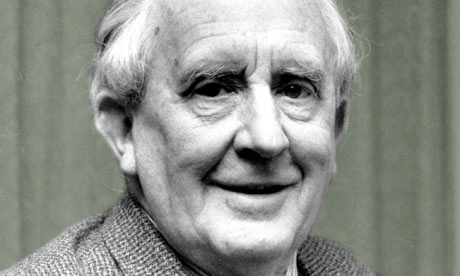
Literary legend has it that British publisher Stanley Unwin paid his nephew to read J.R.R. Tolkien’s first submitted manuscript, and only took on the fantasy story once it had received a good review from the child. Tolkien went on to write his most popular work with the counsel and support of his publisher. Below, he fields questions about a possible sequel to The Hobbit.
To Stanley Unwin
16 December 1937
20 Nonhmoor Road, Oxford
Dear Mr Unwin,
I have been ill and am still rather tottery, and have had others of the common human troubles, so that time has slipped out of my hands: I have accomplished next to nothing of any kind since I saw you…
My chief joy comes from learning that the Silmarillion is not rejected with scorn. I have suffered a sense of fear and bereavement, quite ridiculous, since I let this private and beloved nonsense out; and I think if it had seemed to you to be nonsense I should have felt really crushed. I do not mind about the verse-form, which in spite of certain virtuous passages has grave defects, for it is only for me the rough material. But I shall certainly now hope one day to be able, or to be able to afford, to publish the Silmarillion! Your reader’s comment affords me delight. I am sorry the names split his eyes—personally I believe (and here believe I am a good judge) they are good, and a large part of the effect. They are coherent and consistent and made upon two related linguistic formulae, so that they achieve a reality not fully achieved to my feeling by other name-inventors (say Swift or Dunsany!). Needless to say they are not Celtic!
Neither are the tales. I do know Celtic things (many in their original languages Irish and Welsh), and feel for them a certain distaste: largely for their fundamental unreason. They have bright colour, but are like a broken stained glass window reassembled without design. They are in fact ‘mad’ as your reader says—but I don’t believe I am. Still I am very grateful for his words, and particularly encouraged that the style is good for the purpose and even gets over the nomenclature.
I did not think any of the stuff I dropped on you filled the bill. But I did want to know whether any of the stuff had any exterior non-personal value. I think it is plain that quite apart from it, a sequel or successor to The Hobbit is called for. I promise to give this thought and attention. But I am sure you will sympathize when I say that the construction of elaborate and consistent mythology (and two languages) rather occupies the mind, and the Silmarils are in my heart. So that goodness knows what will happen. Mr Baggins began as a comic tale among conventional and inconsistent Grimm’s fairy-tale dwarves, and got drawn into the edge of it—so that even Sauron the terrible peeped over the edge. And what more can hobbits do? They can be comic, but their comedy is suburban unless it is set against things more elemental. But the real fun about orcs and dragons (to my mind) was before their time…
Is there a spare [drawing] available of the dragon on his hoard? I have to give a lecture on dragons, (at the Natural History Museum!!!) and they want a picture to make a slide of…
Could I have four more copies of the Hobbit at author’s rates, to use as Christmas presents?
May I wish you bon voyage – and a safe return. I am supposed to be broadcasting from BBC on Jan 14th, but that will I suppose be after your return. I shall look forward to seeing you again.
Yours sincerely
J. R. R. Tolkien
P.S. I have received several queries, on behalf of children and adults, concerning the runes and whether they are real and can be read. Some children have tried to puzzle them out. Would it be a good thing to provide a runic alphabet? I have had to write one out for several people. Please excuse scrawling and rambling nature of this letter. I feel only half-alive. JRRT.
From The Letters of J.R.R. Tolkien. Ed. Humphrey Carter and Christopher Tolkien. London: George Allen & Unwin, 2000.
FURTHER READING
Read about the upcoming Tolkien biopic.
National Geographic explores aspects of the real physical terrain that inspired Tolkien settings fictional topogrophies.


